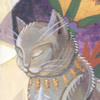
from: http://www.nilecommerce.net/statues/goddess_statues.htm
Bast, The Cat-Goddess Cat-goddess Bast was also known as Bastet and to the Greeks, who, strangely considered her to be a virgin, Artemis. An alternative name was Pesht - the origin of "Puss." Bast's cult center was at Bubastis (modern-day Tell Basta, north of Giza) which came to prominence during the rule of the Libyan pharoah Sheshon I, in the middle of the tenth centure BCE.  As Bubastis was his residence, the city and its principal goddess Bast rose to fame and prominence within the Egyptian pantheon. Miwsher, meaning "little cat" or "pussycat," became a popular nickname for Egyptian girls. As Bubastis was his residence, the city and its principal goddess Bast rose to fame and prominence within the Egyptian pantheon. Miwsher, meaning "little cat" or "pussycat," became a popular nickname for Egyptian girls. Bast was protrayed as a cat, or as a woman with the head of her sacred animal. She had a reputation for ferocity, as a protector from demons and disease. Her gentler side was as the sensuous diety of music, pleasure, dance, and fertility. Her feminine qualities associate her with Hathor.  Bast may have been another form of that goddess or considered to be her sister, and as the possible daughter of Isis. Such is the nature of the convoluted family relationships of the gods of Old Egypt. Festivals at her hometown of Bubastis, recorded by Herodotus, were held during April and May when the citizens took to sailing boats, singing and playing drums. Bast figurines often show her holding a sistrum, an ancient Eglyptian percussion instrument. The sistrum provides another link to Hathor, a goddess with whom Bast shares many attributes. This musical instrument was considered to be the sacred symbol of laughing Hathor, patroness of passion and drunkenness. Bast may have been another form of that goddess or considered to be her sister, and as the possible daughter of Isis. Such is the nature of the convoluted family relationships of the gods of Old Egypt. Festivals at her hometown of Bubastis, recorded by Herodotus, were held during April and May when the citizens took to sailing boats, singing and playing drums. Bast figurines often show her holding a sistrum, an ancient Eglyptian percussion instrument. The sistrum provides another link to Hathor, a goddess with whom Bast shares many attributes. This musical instrument was considered to be the sacred symbol of laughing Hathor, patroness of passion and drunkenness.-Isis, Queen of Egyptian Magic, page 109 Background and waggy-tail kitty below images from: http://hem.passagen.se/kattmor/katter.htm |


